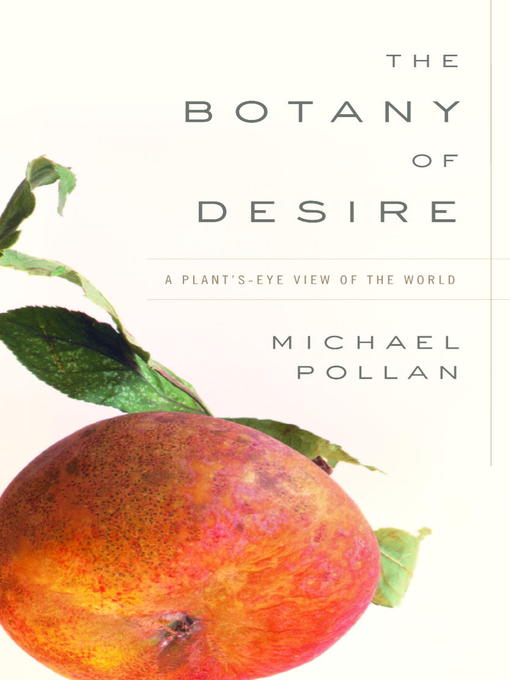
The Botany of Desire
A Plant's-Eye View of the World
فرمت کتاب
ebook
تاریخ انتشار
2001
Lexile Score
1350
Reading Level
11-12
نویسنده
Matthew Accarrinoنویسنده
Jonathan D. Sarnaنویسنده
Matthew Accarrinoنویسنده
Jonathan D. Sarnaنویسنده
Michael Pollanشابک
9781588360083
کتاب های مرتبط
- اطلاعات
- نقد و بررسی
- دیدگاه کاربران
نقد و بررسی

Starred review from April 9, 2001
Erudite, engaging and highly original, journalist Pollan's fascinating account of four everyday plants and their coevolution with human society challenges traditional views about humans and nature. Using the histories of apples, tulips, potatoes and cannabis to illustrate the complex, reciprocal relationship between humans and the natural world, he shows how these species have successfully exploited human desires to flourish. "It makes just as much sense to think of agriculture as something the grasses did to people as a way to conquer the trees," Pollan writes as he seamlessly weaves little-known facts, historical events and even a few amusing personal anecdotes to tell each species' story. For instance, he describes how the apple's sweetness—and the appeal of hard cider—enticed settlers to plant orchards throughout the American colonies, vastly expanding the plant's range. He evokes the tulip craze of 17th-century Amsterdam, where the flower's beauty led to a frenzy of speculative trading, and explores the intoxicating appeal of marijuana by talking to scientists, perusing literature and even visiting a modern marijuana garden in Amsterdam. Finally, he considers how the potato plant demonstrates man's age-old desire to control nature, leading to modern agribusiness's experiments with biotechnology. Pollan's clear, elegant style enlivens even his most scientific material, and his wide-ranging references and charming manner do much to support his basic contention—that man and nature are and will always be "in this boat together."

Starred review from April 30, 2007
On the sixth anniversary of its original publication, Pollan’s scientific twist on the human/plant symbiosis makes its audio debut. Pollan preaches a unique sort of romantic environmentalism where humans and plants satisfy each other’s desires for survival, enjoyment, satisfaction and escape. He uses the apple, tulip, Cannabis and potato to develop his ideas, offering the histories of each and how they developed reciprocal relationships with the humans with whom each interacted. Scott Brick exudes excitement and breathes life into the recording—the timbre of his voice offering just the right touch of humor and depth. Listeners will feel like Brick truly loves the book and loves reading it aloud. It’s a great combination for listeners: interesting subject, great writing and wonderful reading. Definitely not to be missed. (Reviews, Apr. 9, 2001)

May 1, 2001
Plants are important to us for many reasons. Pollan, an editor and contributor to Harper's and the New York Times Magazine and author of Second Nature: A Gardener's Education, muses on our complex relationships with them, using the examples of the apple, the tulip, the marijuana plant, and the potato. He weaves disparate threads from personal, scientific, literary, historical, and philosophical sources into an intriguing and somehow coherent narrative. Thus, he portrays Johnny Appleseed as an important force in adapting apple trees to a foreign climate but also a Dionysian figure purveying alcohol to settlers; tulips as ideals of beauty that brought about disaster to a Turkish sultan and Dutch investors; marijuana as a much desired drug related to a natural brain chemical that helps us forget as well as a bonanza for scientific cultivators; and the potato, a crop once vilified as un-Christian, as the cause of the Irish famine and finally an example of the dangers of modern chemical-intense, genetically modified agriculture. These essays will appeal to those with a wide range of interests. Recommended for all types of libraries. [For more on the tulip, see Anna Pavord's The Tulip (LJ 3/1/99) and Mike Dash's Tuplipomania: The Story of the World's Most Coveted Flower & the Extraordinary Passions It Aroused (LJ 3/1/00). Ed.] Marit S. Taylor, Auraria Lib., Denver
Copyright 2001 Library Journal, LLC Used with permission.

Starred review from April 15, 2001
Pollan has an epiphany in his garden: what if the plant species humankind has nurtured over the last 10,000 years benefit as much from us as we do from them? Do humans choose to plant potatoes, or do potatoes attract humans like a flower lures a bee? Ablaze with this transformational vision, Pollan intertwines history, anecdote, and revelation as he investigates the connection between four plants that have thrived under human care--apples, tulips, marijuana, and potatoes--and the four human desires they satisfy in return: sweetness, beauty, intoxication, and control. In the process, he casts new light on the legend of Johnny Appleseed. Holland's mania for tulips serves as a catalyst for a galvanizing discussion of why we wouldn't exist if flowers hadn't evolved. His refreshingly open-minded consideration of marijuana leads to profound reflections on the workings of the brain and the role psychoactive plants have played in the evolution of religion and culture. And, finally, Pollan ponders the Pandora's box of genetic engineering when he plants a patch of NewLeaf, a beetle-killing potato patented by Monsanto. Pollan's dynamic, intelligent, and intrepid parsing of the wondrous dialogue between plants and humans is positively paradigm-altering.(Reprinted with permission of Booklist, copyright 2001, American Library Association.)

























دیدگاه کاربران